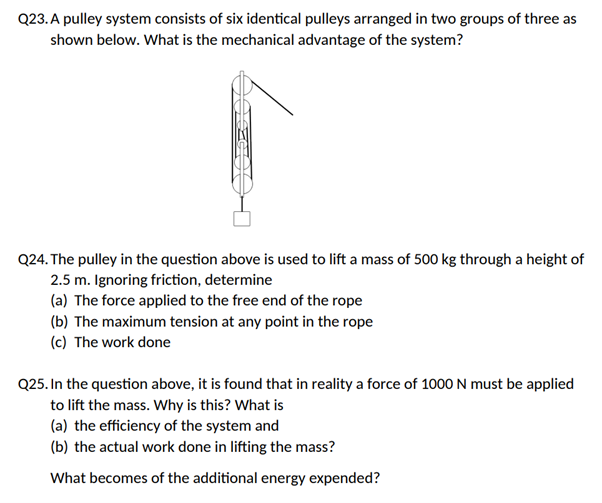Q23. A pulley system consists of six identical pulleys arranged in two groups of three as shown below. What is the mechanical advantage of the system? Q24. The pulley in the question above is used to lift a mass of 500 kg through a height of 2.5 m. Ignoring friction, determine (a) The force applied to the free end of the rope (b) The maximum tension at any point in the rope (c) The work done Q25. In the question above, it is found that in reality a force of 1000 N must be applied to lift the mass. Why is this? What is (a) the efficiency of the system and (b) the actual work done in lifting the mass? What becomes of the additional energy expended?
Q23. A pulley system consists of six identical pulleys arranged in two groups of three as shown below. What is the mechanical advantage of the system? Q24. The pulley in the question above is used to lift a mass of 500 kg through a height of 2.5 m. Ignoring friction, determine (a) The force applied to the free end of the rope (b) The maximum tension at any point in the rope (c) The work done Q25. In the question above, it is found that in reality a force of 1000 N must be applied to lift the mass. Why is this? What is (a) the efficiency of the system and (b) the actual work done in lifting the mass? What becomes of the additional energy expended?
College Physics
1st Edition
ISBN:9781938168000
Author:Paul Peter Urone, Roger Hinrichs
Publisher:Paul Peter Urone, Roger Hinrichs
Chapter7: Work, Energy, And Energy Resources
Section: Chapter Questions
Problem 64PE: Integrated Concepts (a) What force must be supplied by an elevator cable to produce an acceleration...
Related questions
Question
answers:
Q23) 6
Q24a) 820N b) 820N c) 12kJ
Q25a) 0.82 b) 15kJ

Transcribed Image Text:Q23. A pulley system consists of six identical pulleys arranged in two groups of three as
shown below. What is the mechanical advantage of the system?
Q24. The pulley in the question above is used to lift a mass of 500 kg through a height of
2.5 m. Ignoring friction, determine
(a) The force applied to the free end of the rope
(b) The maximum tension at any point in the rope
(c) The work done
Q25. In the question above, it is found that in reality a force of 1000 N must be applied
to lift the mass. Why is this? What is
(a) the efficiency of the system and
(b) the actual work done in lifting the mass?
What becomes of the additional energy expended?
Expert Solution
This question has been solved!
Explore an expertly crafted, step-by-step solution for a thorough understanding of key concepts.
Step by step
Solved in 3 steps

Knowledge Booster
Learn more about
Need a deep-dive on the concept behind this application? Look no further. Learn more about this topic, physics and related others by exploring similar questions and additional content below.Recommended textbooks for you

College Physics
Physics
ISBN:
9781938168000
Author:
Paul Peter Urone, Roger Hinrichs
Publisher:
OpenStax College

Physics for Scientists and Engineers: Foundations…
Physics
ISBN:
9781133939146
Author:
Katz, Debora M.
Publisher:
Cengage Learning


College Physics
Physics
ISBN:
9781938168000
Author:
Paul Peter Urone, Roger Hinrichs
Publisher:
OpenStax College

Physics for Scientists and Engineers: Foundations…
Physics
ISBN:
9781133939146
Author:
Katz, Debora M.
Publisher:
Cengage Learning


Physics for Scientists and Engineers, Technology …
Physics
ISBN:
9781305116399
Author:
Raymond A. Serway, John W. Jewett
Publisher:
Cengage Learning

University Physics Volume 1
Physics
ISBN:
9781938168277
Author:
William Moebs, Samuel J. Ling, Jeff Sanny
Publisher:
OpenStax - Rice University

College Physics
Physics
ISBN:
9781305952300
Author:
Raymond A. Serway, Chris Vuille
Publisher:
Cengage Learning